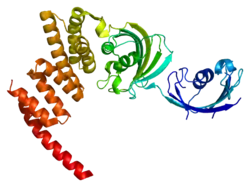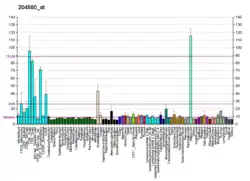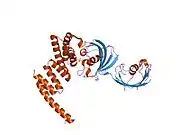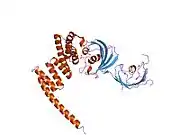FKBP5
FK506 binding protein 5, also known as FKBP5, is a protein which in humans is encoded by the FKBP5 gene.[5]
| FKBP5 | |||||||||||||||||||||||||||||||||||||||||||||||||||
|---|---|---|---|---|---|---|---|---|---|---|---|---|---|---|---|---|---|---|---|---|---|---|---|---|---|---|---|---|---|---|---|---|---|---|---|---|---|---|---|---|---|---|---|---|---|---|---|---|---|---|---|
 | |||||||||||||||||||||||||||||||||||||||||||||||||||
| |||||||||||||||||||||||||||||||||||||||||||||||||||
| Identifiers | |||||||||||||||||||||||||||||||||||||||||||||||||||
| Aliases | FKBP5, AIG6, FKBP51, FKBP54, P54, PPIase, Ptg-10, FK506 binding protein 5, FKBP prolyl isomerase 5 | ||||||||||||||||||||||||||||||||||||||||||||||||||
| External IDs | OMIM: 602623 MGI: 104670 HomoloGene: 3038 GeneCards: FKBP5 | ||||||||||||||||||||||||||||||||||||||||||||||||||
| |||||||||||||||||||||||||||||||||||||||||||||||||||
| |||||||||||||||||||||||||||||||||||||||||||||||||||
| |||||||||||||||||||||||||||||||||||||||||||||||||||
| |||||||||||||||||||||||||||||||||||||||||||||||||||
| |||||||||||||||||||||||||||||||||||||||||||||||||||
| Wikidata | |||||||||||||||||||||||||||||||||||||||||||||||||||
| |||||||||||||||||||||||||||||||||||||||||||||||||||
Function
The protein encoded by this gene is a member of the immunophilin protein family, which play a role in immunoregulation and basic cellular processes involving protein folding and trafficking. This encoded protein is a cis-trans prolyl isomerase that binds to the immunosuppressants tacrolimus (FK506) and sirolimus (rapamycin). It is thought to mediate calcineurin inhibition. It also interacts functionally with mature corticoid receptor hetero-complexes (i.e. progesterone-, glucocorticoid-, mineralocorticoid-receptor complexes) along with the 90 kDa heat shock protein and PTGES3 (P23 protein).[6]
As an Hsp90-associated co-chaperone that regulates the responsiveness of steroid hormone receptors, FKBP51 plays an important role in stress endocrinology and glucocorticoid signaling.[6]
Clinical significance
The FKBP5 gene has been found to have multiple polyadenylation sites[5] and is statistically associated with a higher rate of depressive disorders.[7]
Decreased methylation in the promoter of the FKBP5 gene has been observed in blood samples from patients with neurodegenerative diseases.[8]
FKBP51 Ligands
As a key player in several diseases like stress-related disorders, chronic pain, and obesity, FKBP51 is an attractive drug target. SAFit2 currently the most best characterized FKBP51 ligand, has shown promising effects in numerous animal models.[6] Macrocyclic FKBP51-selective ligands are non-immunosuppressive, engage FKBP51 in cells, and block the cellular effect of FKBP51.[9]
Interactions
FKBP5 has been shown to interact with Heat shock protein 90kDa alpha (cytosolic), member A1.[10]
See also
References
- GRCh38: Ensembl release 89: ENSG00000096060 - Ensembl, May 2017
- GRCm38: Ensembl release 89: ENSMUSG00000024222 - Ensembl, May 2017
- "Human PubMed Reference:". National Center for Biotechnology Information, U.S. National Library of Medicine.
- "Mouse PubMed Reference:". National Center for Biotechnology Information, U.S. National Library of Medicine.
- "Entrez Gene: FKBP5 FK506 binding protein 5".
- Hähle A, Merz S, Meyners C, Hausch F (January 2019). "The Many Faces of FKBP51". Biomolecules. 9 (1): 35. doi:10.3390/biom9010035. PMC 6359276. PMID 30669684.
- Binder EB, Salyakina D, Lichtner P, Wochnik GM, Ising M, Pütz B, et al. (December 2004). "Polymorphisms in FKBP5 are associated with increased recurrence of depressive episodes and rapid response to antidepressant treatment". Nature Genetics. 36 (12): 1319–25. doi:10.1038/ng1479. PMID 15565110. S2CID 21914515.
- Nabais MF, Laws SM, Lin T, Vallerga CL, Armstrong NJ, Blair IP, et al. (March 2021). "Meta-analysis of genome-wide DNA methylation identifies shared associations across neurodegenerative disorders". Genome Biology. 22 (1): 90. doi:10.1186/s13059-021-02275-5. PMC 8004462. PMID 33771206.
- Voll AM, Meyners C, Taubert MC, Bajaj T, Heymann T, Merz S, et al. (June 2021). "Macrocyclic FKBP51 Ligands Define a Transient Binding Mode with Enhanced Selectivity". Angewandte Chemie. 60 (24): 13257–13263. doi:10.1002/anie.202017352. PMC 8252719. PMID 33843131.
- Nair SC, Rimerman RA, Toran EJ, Chen S, Prapapanich V, Butts RN, Smith DF (February 1997). "Molecular cloning of human FKBP51 and comparisons of immunophilin interactions with Hsp90 and progesterone receptor". Molecular and Cellular Biology. 17 (2): 594–603. doi:10.1128/MCB.17.2.594. PMC 231784. PMID 9001212.
- Prakash, Ajit; Shin, Joon; Rajan, Sreekanth; Yoon, Ho Sup (2016-04-07). "Structural basis of nucleic acid recognition by FK506-binding protein 25 (FKBP25), a nuclear immunophilin". Nucleic Acids Research. 44 (6): 2909–2925. doi:10.1093/nar/gkw001. ISSN 0305-1048. PMC 4824100. PMID 26762975.
Further reading
- Schiene-Fischer C, Yu C (April 2001). "Receptor accessory folding helper enzymes: the functional role of peptidyl prolyl cis/trans isomerases". FEBS Letters. 495 (1–2): 1–6. doi:10.1016/S0014-5793(01)02326-2. PMID 11322937. S2CID 42263861.
- Baughman G, Wiederrecht GJ, Campbell NF, Martin MM, Bourgeois S (August 1995). "FKBP51, a novel T-cell-specific immunophilin capable of calcineurin inhibition". Molecular and Cellular Biology. 15 (8): 4395–402. doi:10.1128/mcb.15.8.4395. PMC 230679. PMID 7542743.
- Smith DF, Baggenstoss BA, Marion TN, Rimerman RA (August 1993). "Two FKBP-related proteins are associated with progesterone receptor complexes". The Journal of Biological Chemistry. 268 (24): 18365–71. doi:10.1016/S0021-9258(17)46853-0. PMID 7688746.
- Smith DF, Albers MW, Schreiber SL, Leach KL, Deibel MR (November 1993). "FKBP54, a novel FK506-binding protein in avian progesterone receptor complexes and HeLa extracts". The Journal of Biological Chemistry. 268 (32): 24270–3. doi:10.1016/S0021-9258(20)80520-1. PMID 7693698.
- Maruyama K, Sugano S (January 1994). "Oligo-capping: a simple method to replace the cap structure of eukaryotic mRNAs with oligoribonucleotides". Gene. 138 (1–2): 171–4. doi:10.1016/0378-1119(94)90802-8. PMID 8125298.
- Johnson J, Corbisier R, Stensgard B, Toft D (January 1996). "The involvement of p23, hsp90, and immunophilins in the assembly of progesterone receptor complexes". The Journal of Steroid Biochemistry and Molecular Biology. 56 (1-6 Spec No): 31–7. doi:10.1016/0960-0760(95)00221-9. PMID 8603045. S2CID 24410864.
- Nair SC, Rimerman RA, Toran EJ, Chen S, Prapapanich V, Butts RN, Smith DF (February 1997). "Molecular cloning of human FKBP51 and comparisons of immunophilin interactions with Hsp90 and progesterone receptor". Molecular and Cellular Biology. 17 (2): 594–603. doi:10.1128/MCB.17.2.594. PMC 231784. PMID 9001212.
- Baughman G, Wiederrecht GJ, Chang F, Martin MM, Bourgeois S (March 1997). "Tissue distribution and abundance of human FKBP51, and FK506-binding protein that can mediate calcineurin inhibition". Biochemical and Biophysical Research Communications. 232 (2): 437–43. doi:10.1006/bbrc.1997.6307. PMID 9125197.
- Suzuki Y, Yoshitomo-Nakagawa K, Maruyama K, Suyama A, Sugano S (October 1997). "Construction and characterization of a full length-enriched and a 5'-end-enriched cDNA library". Gene. 200 (1–2): 149–56. doi:10.1016/S0378-1119(97)00411-3. PMID 9373149.
- Young JC, Obermann WM, Hartl FU (July 1998). "Specific binding of tetratricopeptide repeat proteins to the C-terminal 12-kDa domain of hsp90". The Journal of Biological Chemistry. 273 (29): 18007–10. doi:10.1074/jbc.273.29.18007. PMID 9660753.
- Hartley JL, Temple GF, Brasch MA (November 2000). "DNA cloning using in vitro site-specific recombination". Genome Research. 10 (11): 1788–95. doi:10.1101/gr.143000. PMC 310948. PMID 11076863.
- Wiemann S, Weil B, Wellenreuther R, Gassenhuber J, Glassl S, Ansorge W, et al. (March 2001). "Toward a catalog of human genes and proteins: sequencing and analysis of 500 novel complete protein coding human cDNAs". Genome Research. 11 (3): 422–35. doi:10.1101/gr.GR1547R. PMC 311072. PMID 11230166.
- Pirkl F, Buchner J (May 2001). "Functional analysis of the Hsp90-associated human peptidyl prolyl cis/trans isomerases FKBP51, FKBP52 and Cyp40". Journal of Molecular Biology. 308 (4): 795–806. doi:10.1006/jmbi.2001.4595. PMID 11350175.
- Davies TH, Ning YM, Sánchez ER (February 2002). "A new first step in activation of steroid receptors: hormone-induced switching of FKBP51 and FKBP52 immunophilins". The Journal of Biological Chemistry. 277 (7): 4597–600. doi:10.1074/jbc.C100531200. PMID 11751894.
- Giraudier S, Chagraoui H, Komura E, Barnache S, Blanchet B, LeCouedic JP, et al. (October 2002). "Overexpression of FKBP51 in idiopathic myelofibrosis regulates the growth factor independence of megakaryocyte progenitors". Blood. 100 (8): 2932–40. doi:10.1182/blood-2002-02-0485. PMID 12351405.
- Sinars CR, Cheung-Flynn J, Rimerman RA, Scammell JG, Smith DF, Clardy J (February 2003). "Structure of the large FK506-binding protein FKBP51, an Hsp90-binding protein and a component of steroid receptor complexes". Proceedings of the National Academy of Sciences of the United States of America. 100 (3): 868–73. Bibcode:2003PNAS..100..868S. doi:10.1073/pnas.0231020100. PMC 298693. PMID 12538866.
- Hubler TR, Denny WB, Valentine DL, Cheung-Flynn J, Smith DF, Scammell JG (June 2003). "The FK506-binding immunophilin FKBP51 is transcriptionally regulated by progestin and attenuates progestin responsiveness". Endocrinology. 144 (6): 2380–7. doi:10.1210/en.2003-0092. PMID 12746298.
- Bouwmeester T, Bauch A, Ruffner H, Angrand PO, Bergamini G, Croughton K, et al. (February 2004). "A physical and functional map of the human TNF-alpha/NF-kappa B signal transduction pathway". Nature Cell Biology. 6 (2): 97–105. doi:10.1038/ncb1086. PMID 14743216. S2CID 11683986.






